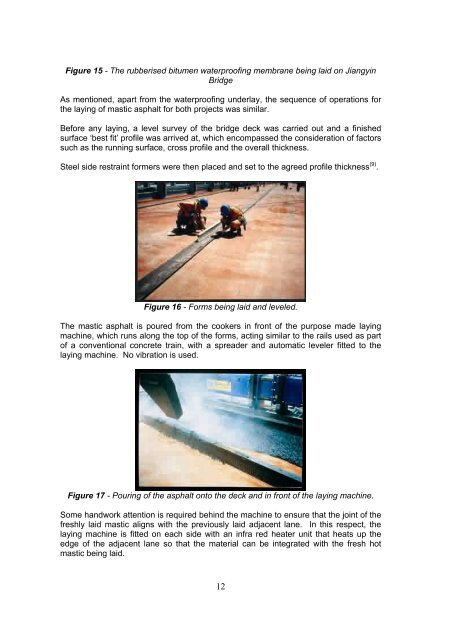MASTIC ASPHALT FOR PAVEMENT SURFACING
MASTIC ASPHALT FOR PAVEMENT SURFACING
MASTIC ASPHALT FOR PAVEMENT SURFACING
You also want an ePaper? Increase the reach of your titles
YUMPU automatically turns print PDFs into web optimized ePapers that Google loves.
Figure 15 - The rubberised bitumen waterproofing membrane being laid on Jiangyin<br />
Bridge<br />
As mentioned, apart from the waterproofing underlay, the sequence of operations for<br />
the laying of mastic asphalt for both projects was similar.<br />
Before any laying, a level survey of the bridge deck was carried out and a finished<br />
surface ‘best fit’ profile was arrived at, which encompassed the consideration of factors<br />
such as the running surface, cross profile and the overall thickness.<br />
Steel side restraint formers were then placed and set to the agreed profile thickness (9) .<br />
Figure 16 - Forms being laid and leveled.<br />
The mastic asphalt is poured from the cookers in front of the purpose made laying<br />
machine, which runs along the top of the forms, acting similar to the rails used as part<br />
of a conventional concrete train, with a spreader and automatic leveler fitted to the<br />
laying machine. No vibration is used.<br />
Figure 17 - Pouring of the asphalt onto the deck and in front of the laying machine.<br />
Some handwork attention is required behind the machine to ensure that the joint of the<br />
freshly laid mastic aligns with the previously laid adjacent lane. In this respect, the<br />
laying machine is fitted on each side with an infra red heater unit that heats up the<br />
edge of the adjacent lane so that the material can be integrated with the fresh hot<br />
mastic being laid.<br />
12


